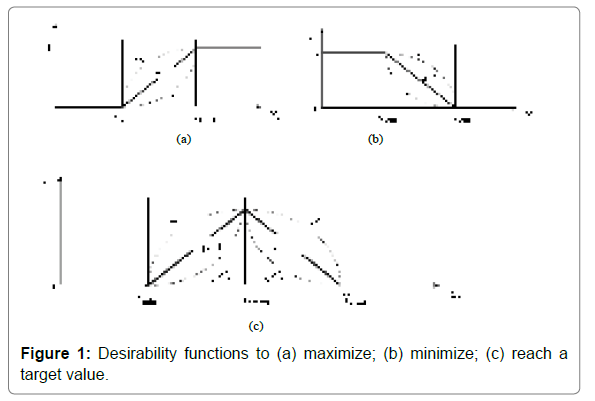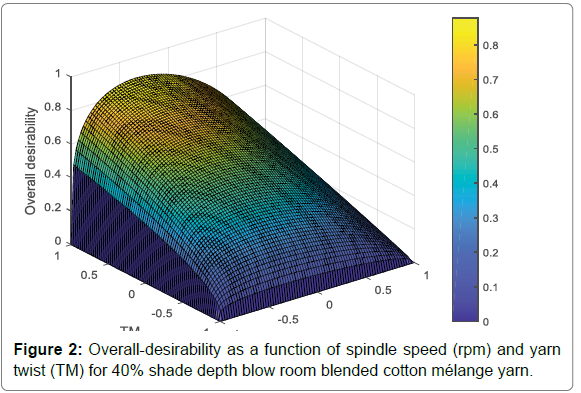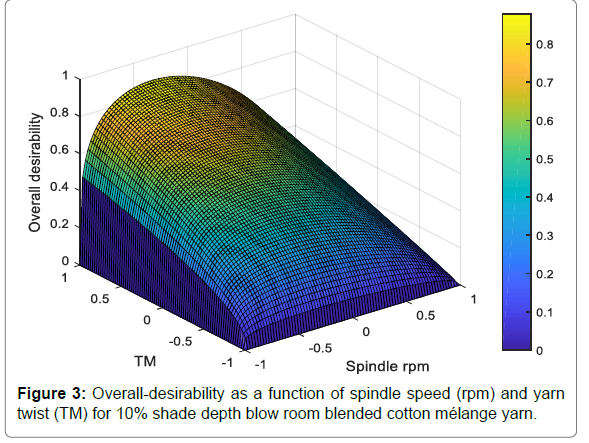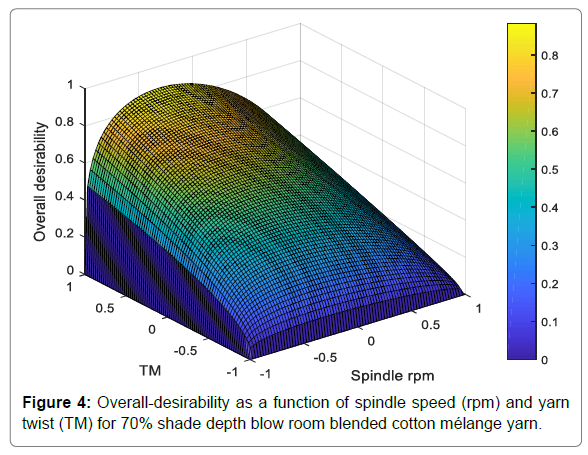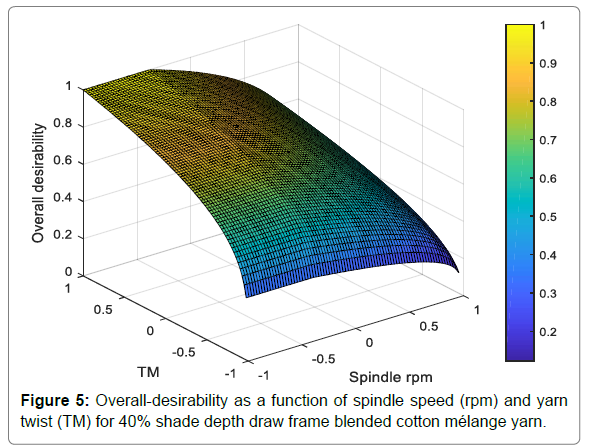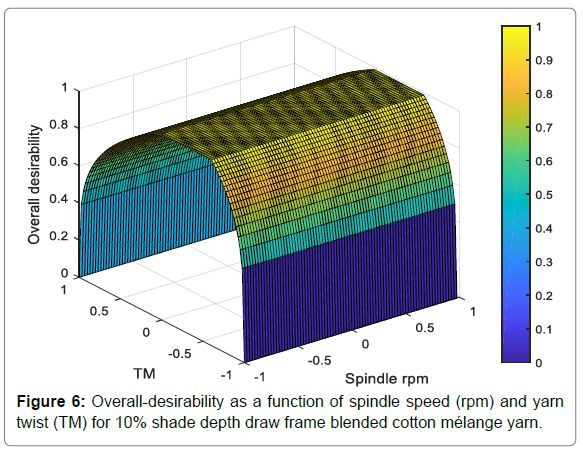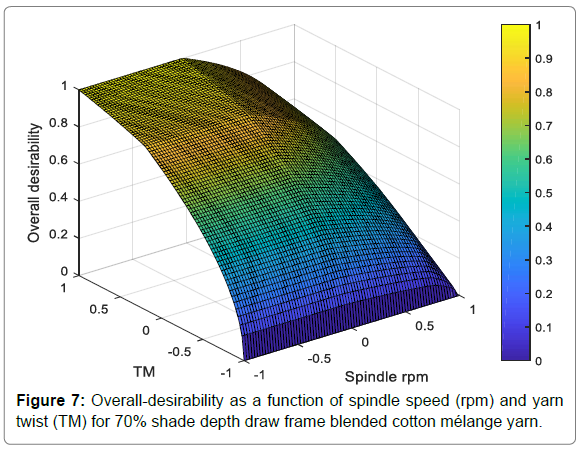Research Article, J Fashion Technol Textile Eng Vol: 9 Issue: 10
Optimization of Cotton Melange Yarn Quality Using Desirability Function
Suchibrata Ray1*, Anindya Ghosh2 and Debamalya Banerjee3
1Government College of Engineering and Textile Technology, Serampore, Hooghly, West Bengal
2Government College of Engineering and Textile Technology, Berhampore, Murshidabad, West Bengal
3Jadavpur University, Kolkata, West Bengal
- *Corresponding Author:
- Suchibrata Ray
Government College of Engineering and Textile Technology, Serampore, Hooghly, West Bengal
Tel: 9088012650
E-mail: raysuchi@yahoo.co.in
Received Date: September 16, 2021; Accepted Date: October 22, 2021; Published Date: October 29, 2021
Citation: Ray S, Ghosh A, Banerjee D (2021) Optimization of Cotton Melange Yarn Quality Using Desirability Function. J Fashion Technol Textile Eng 9:10. 225.
Copyright: © All articles published in Journal of Fashion Technology & Textile Engineering are the property of SciTechnol, and is protected by copyright laws. Copyright © 2021, SciTechnol, All Rights Reserved.
Abstract
This paper deals with the optimization of different quality parameters of blow room blended and draw frame blended cotton melange yarn using the desirability function approach. Melange yarn qualities such as tenacity, evenness, imperfection and hairiness index are combined to yield as ‘overall desirability’. The overall desirability has been maximized against target values for yarn tenacity and minimized versus target values for yarn evenness, imperfection and hairiness index. Experimental validation confirms that the applied method can be effectively used to manufacture a cotton melange yarn with desired quality characteristics.
Keywords: Blow room blending; Draw frame blending; Desirability function; Mélange yarn; Optimization; Yarn quality
Introduction
The textile industry is now capable to produce various kinds of yarns and fabrics with special appearance by varying product mix and structure. The increasing trend in the demand of fancy yarns is observed in the era of modern fashion [1]. Mélange yarn is one important members of the fancy yarn family and known for its attractive colour and appearance. Mélange yarn is made out of two or more different coloured fibres which are spun after mixing, therefore creating a unique mixed colour effect. Such type of fancy yarns have advantages for fabric appearance and they can be used in casual wear, sportswear, shirts, business suits, socks and all sorts of cloth products, as well as bed linens, towels, decorative fabrics and other home fabric products. Quality of the melange yarn is the key for the success of these speciality yarns.
Researchers have studied the different quality aspects of melange yarn as well as various difficulties associated with the melange yarn manufacturing. Moghassem [2] stated that mélange yarns are wellknown for their gorgeous colour and look. The process of mélange yarn manufacturing involves the repetition of mechanical action to the fibre. Behera et al. [3] reported that mélange yarns can be produced either by adding different coloured fibres in blow room or by adding different coloured carded sliver with grey sliver in draw frame. Koo et al. [4] noted that the fibre damage during dyeing process degrades the physical properties of the speciality yarn. Ishtiaque and Das [5] observed that the dyed cotton fibre length and related parameters consistently deteriorate in each mechanical processing stages of rotor spinning process and the effect is more prominent in case of natural dyed cotton fibres due to higher frictional coefficient. Karim et al. [6] made a comparative study on the properties of ring spun and rotor spun cotton mélange yarns and found less loss of mechanical properties of ring spun mélange yarn than that of rotor spun mélange yarn. Naik and Bhat [7] observed that the dyeing process of cotton fibres leads to greater entanglement and cohesion among them and further mechanical processes lead to fibre damage which makes the mélange yarn manufacturing process more difficult. An increase in dyed fibre share in the mixture further increases the difficulties in mélange yarn manufacturing. Memon et al. [8] studied the impact of cotton fiber dyeing parameters on mélange yarn properties like yarn evenness, imperfection, strength, elongation and hairiness and they emphasized on the optimization of dyeing parameters for better mélange yarn properties. Regar et al. [9] reported that the compact mélange yarn exhibited better mass uniformity, strength and elongation and less hairiness, coefficient of friction compared to conventional ring spun cotton mélange yarn. Ray et al. [10-12] studied effect of shade depth and various spinning process parameters on cotton melange yarn quality by using Taguchi and Box Behnken design of experiment. They found better cotton melange yarn quality with draw frame blending technique over blow room blending process. The optimization of some important cotton melange yarn quality parameters such as tenacity, evenness, imperfection level and hairiness index requires the adjustment of some process parameters. There is hardly any report on the process parameters optimization of cotton melange yarn manufacturing. Hence, in this present work the desirability function technique has been used to determine the values of the controlled factors that yield maximum desirable value of yarn quality parameters including yarn tenacity, evenness, imperfections and hairiness index, for both blow room blended and draw frame blended cotton melange yarns.
Materials and Methods
Materials: Black dyed and grey combed Sankar 6 cotton fibres have been used to produce 20s Ne blow room blended and draw frame blended mélange yarns. For both the blends, three controlled factors, namely shade depth (%), ring frame spindle speed (rpm) and twist multiplier (TM) were chosen and three levels were selected for each factor. Conventional ring spinning system was used to prepare yarn samples according to the experimental plan of Box and Behnken design of experiment. The controlled factors X1, X2 and X3 correspond to shade depth (%), spindle speed (rpm) and twist multiplier (TM) respectively. The coded values and the actual values of the controlled factors are shown in Table 1.
| Factors | Coded level | Variables | ||
|---|---|---|---|---|
| Shade depth (X1) % |
Spindle speed (X2) rpm |
Yarn TM (X3) |
||
| Blow room blend | -1 | 10 | 12500 | 3.5 |
| 0 | 40 | 13500 | 3.7 | |
| +1 | 70 | 14500 | 3.9 | |
| Draw frame blend | +1 | 10 | 12500 | 3.5 |
| 0 | 40 | 13500 | 3.7 | |
| -1 | 70 | 14500 | 3.9 | |
Table 1: Actual values of the factors corresponding to their coded levels.
Testing: All the fiber and yarn samples were kept in standard atmospheric condition for 24 h before testing. The grey combed fiber, dyed combed fiber and dyed fibres after processing through carding were subjected for their length and strength parameters in HVI 900 and Bare Sorter instruments. The yarn samples were evaluated for yarn unevenness (U %), imperfections (IPI), hairiness index (HI), strength (RKM) and breaking elongation (%). Capacitance based evenness tester USTER 4 was used to examine yarn U%, IPI and HI. The yarn withdrawal speed and testing time were maintained at 400 m/min and 1 min respectively for testing. For each experimental run, 10 readings were taken for measuring the average U%, IPI and HI. The tensile properties of yarns were tested by Uster Tensojet using the specimen test length of 500 mm, extension rate of 400 m/min and pre-tension of 0.5 cN/tex. Average yarn strength and breaking elongation were estimated for each type of yarn sample based on 1000 tests.
Response Surface Equations: A quadratic regression equation model was used to relate various independent factors, namely shade depth, spindle speed, yarn twist with response variables, namely tenacity, evenness, imperfection and hairiness index. Equation (1) shows the general form of the response surface equation:
 (1)
(1)
where  is the predicted value of response and α0, αi,, αij, αii are the regression coefficients of interception, linear terms, interaction terms and quadratic terms respectively. In the fitted regression coefficients which are significant at 95% confidence limits are considered.
is the predicted value of response and α0, αi,, αij, αii are the regression coefficients of interception, linear terms, interaction terms and quadratic terms respectively. In the fitted regression coefficients which are significant at 95% confidence limits are considered.
Desirability function: Harrington [13] developed the concept of desirability function in 1965 and it was further developed by Derringer and Suinch [14]. Ghosh et al. [15] used desirability function approach for optimization of knitted fabric comfort and UV protection. A desirability function (di) is defined individually for each response variables or objectives with goals and boundaries. The desirability functions with different goals and boundaries are shown in Figure 1. There are three types of goals, namely maximize the response, minimize the response and target the response. Equations defining each type of response are expressed in Table 2. The exponents p and q in Table 2 determine the degree of importance to hit the target value. The desirability function approaches linearly for p = q = 1. The desirability function is convex for p < 1, q < 1 and is concave for p > 1, q > 1. Individual desirability function (di) values are combined to calculate the overall desirability function for optimization.
| Maximize the response | Minimize the response | Target the response | |
|---|---|---|---|
 where Ymin ≤ Yi ≤ Ytarget di = 0, if Yi ≤ Ymin di = 1, if Yi ≥ Ytarget |
 where Ytarget ≤ Yi ≤ Ymax di = 0, if Yi ≥ Ymax di = 1, if Yi ≤ Ytarget |
 where Ymin ≤ Yi ≤ Ytarget di = 0, if Yi ≤ Ymin di = 1, if Yi = Ytarget and  where Ytarget ≤ Yi ≤ Ymax di = 0, if Yi ≥ Ymax di = 1, if Yi = Ytarget |
Table 2: Expressions of desirability functions for different goals.
The equation of ‘overall desirability function’ is manifested in the following equation:
 (2)
(2)
where is the weight of ith response, n is the number of responses. Both the individual desirability function and overall desirability function have a range from zero to one. A desirability of zero corresponds to complete lack of fulfilment of objectives whereas a value of one implies complete fulfilment.
is the weight of ith response, n is the number of responses. Both the individual desirability function and overall desirability function have a range from zero to one. A desirability of zero corresponds to complete lack of fulfilment of objectives whereas a value of one implies complete fulfilment.
Results and Discussion
A quadratic regression model was used to relate the shade depth, spindle speed and yarn twist multiplier to the yarn tenacity, evenness, imperfections and hairiness index for both the types of blending method. Equation 1 depicts the general form of the quadratic regression models. The regression coefficients and p-values of all terms for blow room blended and draw frame blended cotton melange yarns are shown in Tables 3 and 4 respectively. The regression coefficients, which are significant at 95% confidence level, were considered for further investigations. The regression coefficients with p-values less than 0.05 are statistically significant at a 95% confidence level. The response surface equations for yarn unevenness, tenacity, imperfections and hairiness index and their corresponding coefficients of determination (R2) for both the types of blending method are shown in Table 5.
| Model term | Unevenness U (%) |
Yarn tenacity (g/tex) |
Imperfection (IPI) |
Hairiness index (HI) |
||||
|---|---|---|---|---|---|---|---|---|
| Coeff. | p-value | Coeff. | p-value | Coeff. | p-value | Coeff. | p-value | |
| Constant | 9.693 | 0.000 | 18.513 | 0 | 49.467 | 0 | 4.7 | 0 |
| X1 | 0.211 | 0.003 | -0.97 | 0.000 | 11.037 | 0.0003 | 0.5 | 0.00003 |
| X2 | 0.090 | 0.076 | -0.111 | 0.379 | 5.025 | 0.010 | -0.006 | 0.866 |
| X3 | 0.013 | 0.747 | 0.556 | 0.004 | -1.762 | 0.220 | -0.106 | 0.030 |
| X12 | -0.319 | 0.003 | -0.445 | 0.046 | 5.667 | 0.028 | 0.033 | 0.546 |
| X22 | 0.158 | 0.044 | 0.102 | 0.574 | 2.491 | 0.236 | 0.036 | 0.518 |
| X32 | 0.080 | 0.232 | -0.207 | 0.275 | -4.033 | 0.081 | 0.026 | 0.636 |
| X1X2 | 0.007 | 0.900 | 0.315 | 0.111 | 0.075 | 0.968 | 0 | 1 |
| X1X3 | 0.010 | 0.867 | -0.015 | 0.930 | 0.55 | 0.769 | 0 | 1 |
| X2X3 | -0.107 | 0.118 | -0.067 | 0.696 | 0.225 | 0.904 | 0.107 | 0.084 |
Table 3: Estimated Coefficients (Coeff.) and p-values of model terms for different response variables for blow room blended cotton melange yarn.
| Model term | Unevenness (U%) |
Yarn tenacity (g/tex) |
Imperfection (IPI) |
Hairiness index (HI) |
||||
|---|---|---|---|---|---|---|---|---|
| Constant | Coeff | p-value | Coeff | p-value | Coeff | p-value | Coeff | p-value |
| 9.306 | 0.000 | 18.500 | 0.000 | 46.433 | 0.000 | 4.340 | 0.000 | |
| X1 | 0.556 | 0.00001 | -1.437 | 0.0002 | 14.900 | 0.00006 | 0.528 | 0.000 |
| X2 | 0.192 | 0.001 | -0.087 | 0.587 | 5.187 | 0.008 | -0.011 | 0.696 |
| X3 | 0.003 | 0.909 | 0.550 | 0.015 | 0.087 | 0.945 | -0.097 | 0.016 |
| X12 | 0.005 | 0.914 | 0.115 | 0.613 | 2.700 | 0.179 | -0.007 | 0.853 |
| X22 | -0.002 | 0.957 | -0.125 | 0.584 | -1.650 | 0.384 | -0.110 | 0.035 |
| X32 | -0.070 | 0.176 | -0.300 | 0.219 | 0.425 | 0.816 | 0.050 | 0.251 |
| X1X2 | -0.427 | 0.0002 | 0.370 | 0.157 | -0.454 | 0.811 | 0.278 | 0.001 |
| X1X3 | 0.005 | 0.911 | 0.110 | 0.642 | -1.129 | 0.558 | 0.014 | 0.745 |
| X2X3 | -0.017 | 0.727 | 0.115 | 0.627 | -2.579 | 0.212 | 0.011 | 0.790 |
Table 4: Estimated regression coefficients (Coeff) and p-values of model term for different response variables for draw frame blended cotton melange yarn.
| Type of Yarns | Response variables | |||
|---|---|---|---|---|
| Tenacity | Evenness | Imperfections | Hairiness Index | |
| Blow Room Blend | 18.51 - 0.97X1 + 0.56X3 - 0.44X12 |
9.69 + 0.21X1 - 0.32X12 + 0.16X22 |
49.47 + 11.04X1 + 5.02X2+ 5.67X12 | 4.7 + 0.5X1 - 0.11X3 |
| (R2= 0.89) | (R2= 0.81) | (R2= 0.88) | (R2= 0.95) | |
| Draw Frame Blend | 18.5-1.43X1 + 0.55X3 | 9.31+ 0.55X1 + 0.19X2 - 0.43X12 | 46.43 + 14.9X1 + 5.18X2 | 4.34 + 0.52X1-0.09X3 -0.11X1X3 + 0.27X12 |
| (R2= 0.90) | (R2= 0.98) | (R2= 0.94) | (R2= 0.98) | |
Table 5: Response surface equations of various melange yarn quality parameters.
The objective of this present work is to achieve the target values for yarn unevenness, tenacity, and imperfection and hairiness index for both blow room blend and draw frame blended cotton melange yarns by maximizing the ‘overall-desirability’. The maximum value of yarn tenacity and minimum values of yarn evenness, imperfection and hairiness index were set as target values for the blow room blend. The minimum and maximum values for yarn evenness, imperfection, tenacity and hairiness index were estimated from their corresponding response surface equations. Hence, in case of blow room blend, maximize the response equation as shown in the first column of Table 2 was used for yarn tenacity and minimize the response equation as shown in second column of Table 2 was used for yarn evenness, imperfection, hairiness index. However, in case of draw frame blend, the same target values of yarn quality parameters are set that were used for the blow room blend. This may be argued to the fact that cotton melange yarn is sold in the market based on the final yarn quality characteristics, but not by the blending method used in manufacturing. Table 6 shows the target, minimum and maximum values for yarn quality parameters for both type of blending methods with all the three shade depths. In the present study, the values of p and q were chosen as 1. The optimum value of ‘overall desirability’ as expressed in Equation 2 was determined for each type of blending method with three different shade depthusing MATLAB Optimization toolbox. The weight value (wi) was chosen as 1 which implies equal importance among responses.
| Type of Yarns | Responses | Shade depth: 10% | Shade depth: 40% | Shade depth: 70% | ||||||||||||
|---|---|---|---|---|---|---|---|---|---|---|---|---|---|---|---|---|
| Lower Limit | Target | Upper | Lower Limit | Target | Upper Limit | Lower Limit | Target | Upper Limit | ||||||||
| Limit | ||||||||||||||||
| Blow room blend | Tenacity | 18.48 | 19.6 | 19.6 | 17.95 | 19.07 | 19.07 | 16.54 | 17.66 | 17.66 | ||||||
| Evenness | 9.16 | 9.16 | 9.32 | 9.69 | 9.69 | 9.85 | 9.58 | 9.58 | 9.74 | |||||||
| IPI | 39.08 | 39.08 | 49.12 | 44.45 | 44.45 | 54.41 | 61.16 | 61.16 | 71.72 | |||||||
| Hairiness | 4.09 | 4.09 | 4.31 | 4.59 | 4.59 | 4.81 | 5.09 | 5.09 | 5.31 | |||||||
| Draw frame blend | Tenacity | 19.38 | 19.6 | 20.48 | 17.95 | 19.07 | 19.05 | 16.52 | 17.66 | 17.62 | ||||||
| Evenness | 8.14 | 9.16 | 8.52 | 9.12 | 9.69 | 9.5 | 9.24 | 9.58 | 9.62 | |||||||
| IPI | 26.35 | 39.08 | 36.71 | 41.25 | 44.45 | 51.61 | 56.15 | 61.16 | 66.51 | |||||||
| Hairiness | 4.07 | 4.09 | 4.11 | 4.25 | 4.59 | 4.43 | 4.93 | 5.09 | 5.33 | |||||||
Table 6: The boundaries and target values of different responses.
Table 7 depicts the solutions resulting from the optimization problem. In case of blow room blended cotton melange yarn of 10% shade depth, the maximum ‘overall desirability’ value is estimated as 0.88 which corresponds the optimum values of 19.6, 9.18,42.43 and 4.09 for yarn tenacity, evenness, imperfections and hairiness index respectively at 13167 rpm spindle speed and 3.90 yarn TM. Similarly for 40% shade depth, the maximum ‘overall desirability’ value is also estimated as 0.88 which corresponds the optimum values of 19.07,9.71, 47.8 and 4.59 for yarn tenacity, evenness, imperfections and hairiness index respectively at 13167 rpm spindle speed and 3.90 yarn TM, whereas for 70% shade depth, the maximum ‘overall desirability’ value is again estimated as 0.88 which corresponds the optimum values of 17.66, 9.59, 64.59 and 5.09 for yarn tenacity, evenness, imperfections and hairiness index respectively at 13183 rpm spindle speed and 3.90 yarn TM. The overall-desirability curves for blow room blended melange yarns at three different shade depths are shown in Figures 2-4. In case of draw frame blended cotton melange yarn of 10% shade depth, the maximum ‘overall desirability’ value is estimated as 1.0 which corresponds the optimum values of 19.87, 8.31, 31 and 4.09 for yarn tenacity, evenness, imperfections and hairiness index respectively at 13400 rpm spindle speed and 3.68 yarn TM. Similarly for 40% shade depth, the maximum ‘overall desirability’ value is also estimated as 1 which corresponds the optimum values of 19.05, 9.23, 44.41 and 4.25 for yarn tenacity, evenness, imperfections and hairiness index respectively at 13111 rpm spindle speed and 3.90 yarn TM whereas for 70% shade depth, the maximum ‘overall desirability’ value is yet again obtained as 1.0 which corresponds the optimum values of 17.62, 9.42, 61.06 and 4.93 for yarn tenacity, evenness, imperfections and hairiness index respectively at 13449 rpm spindle speed and 3.90 yarn TM. The overall-desirability curves for draw frame blended melange yarns at three different shade depths are shown in Figure 5-7. It is evident from the Table 7 that the better ‘overall desirability’ is achieved for draw frame blended cotton melange yarn over the blow room blended melange yarn even at higher productivity level.
| Type of yarns | Responses | Shade depth: 10% | Shade depth: 40% | Shade depth : 70% | ||||||
|---|---|---|---|---|---|---|---|---|---|---|
| Predicted value of the response | DV | Solutions | Predicted value of the response | DV | Solutions | Predicted value of the response | DV | Solutions | ||
| Blow room blend | Tenacity | 19.60 | 0.88 | X1 = 13167 X2 = 3.90 |
19.07 | 0.88 | X1 = 13167 X2 = 3.90 | 17.66 | 0.88 | X1 = 13183 X2 = 3.90 |
| Evenness | 9.18 | 9.71 | 9.60 | |||||||
| IPI | 42.43 | 47.8 | 64.59 | |||||||
| Hairiness | 4.09 | 4.59 | 5.09 | |||||||
| Draw frame blend | Tenacity | 19.87 | 1 | X1 = 13400 X2 = 3.68 |
19.05 | 1 | X1 = 13111 X2 = 3.90 | 17.62 | 1 | X1 = 13449 X2 = 3.90 |
| Evenness | 8.31 | 9.23 | 9.42 | |||||||
| IPI | 31.01 | 44.41 | 61.06 | |||||||
| Hairiness | 4.09 | 4,25 | 4.93 | |||||||
Table 7: Solutions of optimization problems for cotton melange yarn.
Experimental Validation
The optimization model was validated by comparing actual results and optimum values. For this, blow room blended and draw frame blended 20’s Ne cotton melange yarn samples were produced for all the three shade depths with the respective solutions of spindle rpm and yarn TM. All the yarn samples were again tested for yarn tenacity, evenness, imperfections and hairiness index as per standard testing procedure described in the preceding section. Actual values and calculated optimum values of yarn qualities are shown in Table 8. It is evident from the Table 8 that the actual values of yarn tenacity, evenness, imperfection and hairiness index are very close to the calculated optimum values with an error of less than 5% in all cases for both the blow room blended and draw frame blended cotton melange yarns.
| Type of yarns | Responses | Shade depth: 10% | Shade depth: 40% | Shade depth: 70% | ||||||
|---|---|---|---|---|---|---|---|---|---|---|
| O | A | Error (%) | O | A | Error (%) | O | A | Error (%) | ||
| Blow room blend | Tenacity | 19.60 | 19.40 | 1.02 | 19.07 | 18.63 | 2.33 | 17.66 | 17.12 | 3.06 |
| Evenness | 9.18 | 9.25 | 1.55 | 9.71 | 10.01 | 3.12 | 9.60 | 9.92 | 3.34 | |
| IPI | 42.43 | 44 | 3.71 | 47.8 | 50 | 4.15 | 64.59 | 67.3 | 4.20 | |
| Hairiness | 4.09 | 4.15 | 1.96 | 4.59 | 4.71 | 2.67 | 5.09 | 5.20 | 2.12 | |
| Draw frame blend | Tenacity | 19.87 | 19.8 | 0.38 | 19.05 | 18.84 | 1.12 | 17.62 | 17.52 | 0.62 |
| Evenness | 8.31 | 8.55 | 2.88 | 9.23 | 9.51 | 3.62 | 9.42 | 9.68 | 2.76 | |
| IPI | 31.01 | 30 | 3.26 | 44.41 | 46 | 4.12 | 61.06 | 59 | 3.37 | |
| Hairiness | 4.09 | 4.13 | 1.03 | 4,25 | 4.34 | 2.04 | 4.93 | 5.06 | 2.64 | |
| O– Optimized value, A–Achieved value | ||||||||||
Table 8: Optimized and achieved melange yarn properties.
Conclusion
The overall desirability index was maximized by optimizing multiple yarn properties such as tenacity, evenness, and imperfection and hairiness index against target values. Optimum values are obtained for spindle speed and TM in order to engineer a cotton melange yarn with desired combinations of yarn tenacity, evenness, and imperfection and hairiness index. The experimental results have shown significant agreement between the calculated and actual values of the yarn properties. The desired yarn properties can be achieved with better productivity level with draw frame blending method compared to blow room blending method. This study may be used by a yarn manufacturer to produce cotton melange yarn for target yarn qualities.
References
- Grabowska KE (2008) A Mathematical model of fancy yarn strength, the first model developed in the world. Fibres Text East Eur 16: 9-14.
- Moghassem AR (2008) Study on the dyed cotton fibers damage in spinning processes and its effect on the cotton mélange yarn properties. Res J Text Appar 12: 71-78.
- Behera BK, Hari PK, Bansal S, Singh R (1997) Effect of different blending methods and blending stages on properties of Milange yarn. Indian J Fibre Text Res 22: 84-88.
- Koo JG, Park JW, An SK, Koo YS (2003) Properties of specialty yarns based on raw and dyed cotton. Text Res J 73: 26-30.
- Ishtiaque SM, DasA (2003) Characterization of grey and dyed cotton fibres as well as waste at different stages of rotor spinning process. Indian J Fibre Text Res 28: 65-70.
- Karim SK, Gharehaghaji A A, Tavanaie H (2007) A study of the damage caused to dyed cotton fibres and its effects on the properties of rotor-and ring-spun mélange yarns. Fibres Text East Eur 3: 63-67.
- Hanumanth Naik H S, Bhat P N (2008) Production of metange yarns-A review. Man-Made Text India 51: 161-165.
- Memon H, Ali Khoso N, Memon S (2015) Effect of dyeing parameters on physical properties of fibers and yarns. Int J Appl Sci Eng 4: 401-407.
- Regar M L, Amjad A I, Aikat N (2017) Studies on the properties of ring and compact spun mélange yarn. Int JAdv Res Innov Ideas Educ, 3: 476-483.
- Ray S, Ghosh A, Banerjee D (2018) Effect of Blending Methodologies on Cotton. Mélange Yarn Quality. Fibres Text East Eur 5: 41-46.
- Ray S, Ghosh A, Banerjee D (2018) Analyzing the effect of spinning process variables on blow room blended cotton melange yarn quality. Res J Text Appar 22: 2-14.
- Ray S, Ghosh A & Banerjee D (2018) Effect of spinning process parameters on mélange yarn quality by Taguchi experimental design. Indian J Fibre Text Res 43: 295-300.
- Harrington E C (1965) The Desirability Function. Indu Qual Cont 21: 494 - 498.
- Derringer G, Suich R (1980) Simultaneous optimization of several response variables. J Qual Technol 12: 214-219.
- Ghosh A, Mal P, Majumdar A, Banerjee D (2016) Optimization of Knitted Fabric Comfort and UV protection using desirability function. J Eng Fibers Fabr 11: 20-28.
 Spanish
Spanish  Chinese
Chinese  Russian
Russian  German
German  French
French  Japanese
Japanese  Portuguese
Portuguese  Hindi
Hindi 